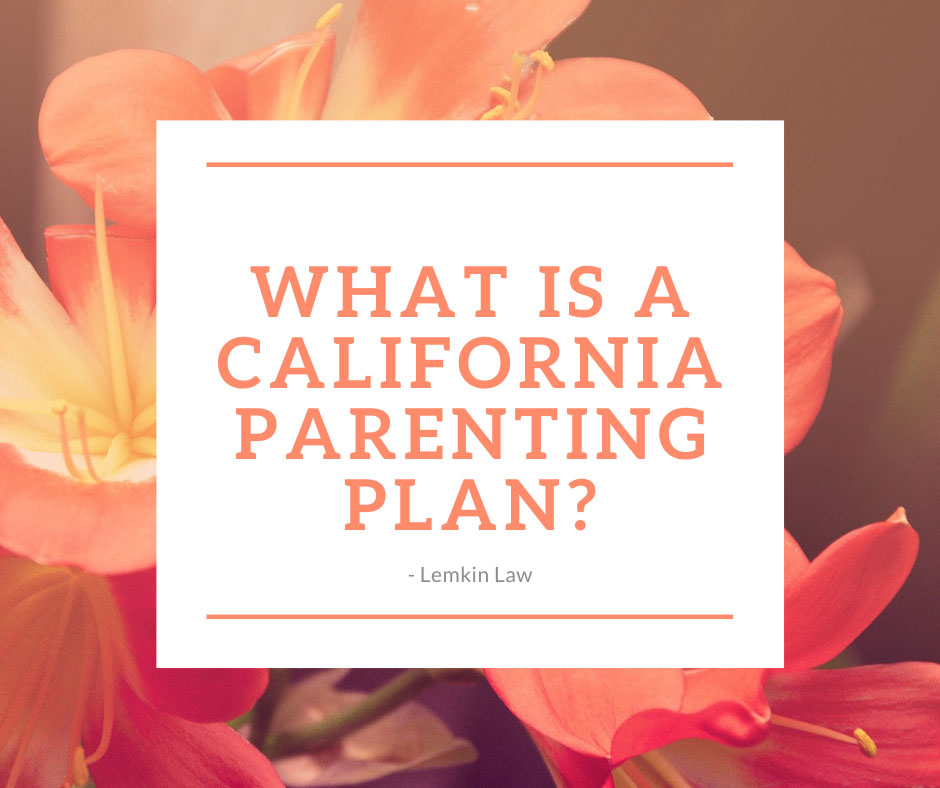What is a California Parenting Plan?
Divorce is a stressful and complex process, and trying to determine what’s best for your children can be challenging.
Children of divorced parents are more than twice as likely as their peers to struggle with emotional and behavioral problems. Parents can help their children avoid emotional upheaval in the wake of divorce through strong co-parenting strategies and deliberate choices that promote stability and consistency for their kids.
The state and the courts push parents in that direction by requiring them to create a California parenting plan and submit it for approval as part of their divorce proceedings. Understanding what these plans require can help divorcing couples make smart choices that work for everyone. Here are the essentials every divorcing couple with children needs to know.
California Parenting Plan Basics
Whenever a couple with children divorces in California, they must explicitly spell out in a legal document how they will handle:
- Custody and visitation
- Parenting rights
- Parenting responsibilities
Importantly, these plans cannot simply reflect whatever the parents think they want. They must be designed around children’s best interests. Whenever possible, they must also promote strong relationships with both parents.
Plans need to take into account children’s ages and emotional and developmental needs. Parents with young children will need to update their plans regularly as children’s schedules and developmental stages change.
Plans must also be approved by the court as part of the divorce proceedings. In general, courts try to respect parental autonomy. However, they may reject any plans that they feel are not in children’s best interests.
Physical vs Legal Custody
To be valid and approved by the court, a custody agreement in California must address both physical custody and legal custody. Physical custody includes the questions of where a child will live, with whom, and when. The plan must spell out:
- Shared custody or visitation schedules
- How children will be transferred from the custody of one parent to the other and by whom
- How parents will handle holidays and other special events or deviations from the standard schedule
- How parents will communicate about plans and handle unexpected changes when they occur
The physical child custody section may also address concerns such as:
- Individuals the children may or may not be left with or exposed to
- Activities that a given parent may not participate in or expose children to during their time together, such as alcohol use
- Limitations on where one parent can take children without informing the other, such as prohibiting unannounced out-of-state trips
In addition to physical custody agreements, plans must address legal custody. Legal custody terms spell out each parent’s rights to weigh in on and make decisions regarding children’s:
- Health care
- Education
- General activities and welfare
In a “sole legal custody” situation, all of those rights go to one parent regardless of the physical custody arrangement. In a “joint legal custody” plan, both parents share the right to make decisions no matter whose custody the child is in at any given time.
Drafting a Plan
So, for example, couples might argue that one parent should retain primary physical custody because that arrangement allows children to stay in their current schools. That promotes continuity and stability and is in the children’s best interest.
In another example, parents of an infant might find their visitation schedule options limited by the realities of caring for a baby. For example, the mother may be breastfeeding. If so, the father cannot feasibly have overnight visitations until after the child is weaned.
Similarly, infants have limited memories and a strong need for consistency. As such, courts are more likely to approve multiple short visits during the week than a single longer visit.
Understanding these factors upfront can help parents construct an appropriate and viable plan.
A Parenting Plan in California Template
The state of California offers an array of forms with ready-made language and checkboxes that divorcing couples can use to help them get started on a plan. To illustrate what a plan might look like when composed, here is a sample plan for the hypothetical Smith family with one child.
Statement of Physical Custody
1. [Mother’s name] and [Father’s name] will have joint legal custody of their child.
2. In the exercise of this shared custody, they may act alone in making decisions as long as those decisions do not violate any existing agreements regarding physical custody. Both parties will share decisions around the child’s health, education, and general welfare. All such decisions must be discussed and consented to by both parties.
This specifically includes:
[x] Enrollment in any school, extra-curricular activities, or daycare programs
[x] Commencement, receipt, or ending of any counseling or therapy
[x] Attendance or participation in religious services or organizations
[x] Out of state travel
3. Each party must notify the other if the child receives medical, dental, or behavioral care from any provider within two days of such care. Both parents have equal rights to access the child’s records and discuss their care with providers.
4. Neither party will change the child’s name or how it is listed with care providers and other authorities without the other’s consent.
5. Both parents will be listed as emergency contacts wherever such information is relevant.
Holiday Schedule
Except where otherwise noted holiday custody begins at 7 a.m. and ends at 8 p.m. The child will spend the following holidays as specified below.
January 1st (New Year’s Day): On even years, the child will be with their mother. On odd years, the child will be with their father.
Spring break, first half: The child will be with their mother every year.
Spring break, second half: The child will be with their father every year.
Mother’s Day: The child will be with their mother every year.
Consequences
If either party fails to comply with this plan as agreed or willfully violates the plan, consequences may include:
[x] Court-imposed penalties up to and including criminal charges
[x] Temporary or permanent changes to the custody agreement
Choosing the Right Custody Arrangements
Divorce is a stressful and complex process, and trying to determine what’s best for your children can be challenging. Figuring out how to act in children’s best interests while also complying with divorce laws can be even harder. Fortunately, you don’t have to navigate the process alone.
If you are divorcing and writing a custody plan for the first time or seeking to update an existing California parenting plan, don’t hesitate to reach out to an attorney. An experienced divorce attorney can help you move forward with confidence and develop a plan that is best for everyone involved.





